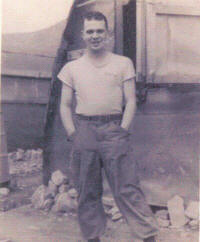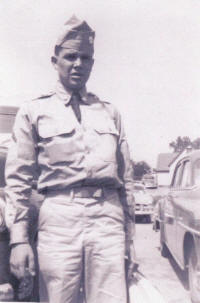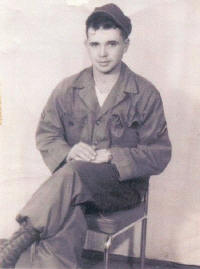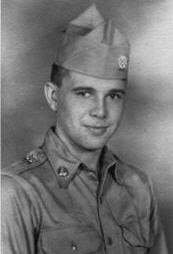National Guard
I joined the Illinois National Guard in Shelbyville, Illinois, on March 12, 1951. I was in G Company, 130th
Infantry Regiment, 44th Division. I was still a senior in high school. We had to attend a two-hour meeting once a
week. At that time, the guard was in the gymnasium of Sparks College. Like every other recruit, I had two left
feet and two hands that were all thumbs. But between Dale Dilley, Phillip Strohl, Bill Sands, and Jay Smith, I
finally got it about halfway right. Sometime after that, the unit went to Camp Lincoln in Springfield to learn how
to shoot an M-1 rifle. I don’t remember how I did, but I do remember that it rained all weekend. The last two
weeks of July we went by train to Camp Ripley, Minnesota, for summer camp. Sometime later in the fall after camp,
they told us what a good job we had done at camp. In fact, it was so good that we were going to be activated into
the regular army February 15, 1952, and would be sent to Camp Cooke, California, for training. Cooke was some 200
miles up the coast from Los Angeles. It is now Vandenberg Air Force Base.
Active Duty
I went on active duty January 17, 1952. I went to leadership school for eight weeks at Fort Leonard Wood,
Missouri. That place has to be the coldest place there ever was in the winter time. At that time, Phillip Strohl,
Tex Blickem, and Jay Smith went there with me. We lived in old World War II wooden barracks that had coal-fired
furnaces. After completing this course, we four came home for about a week, then drove in Strohl’s car to Camp
Cooke. We had no dates on our orders to report, so it took us about five days to get there. There were no
interstates then, but ole Route 66 did have some four-lane and some three-lane sections of road. These three lanes
were called suicide lanes because each direction took turns using the center lane. When it was the other side’s
turn for the center lane, you had a solid yellow line for you not to cross. But they drove then like now, and
drivers had to try and beat the yellow line.
When we arrived in Cooke, it was basic training. Rifle ranges, obstacle courses, tactical problems, gas
chambers, 15 to 30 mile marches with full field pack, three and four-day bivouacs in the field. Then there was the
usual guard duty and KP, and whatever other forms of good stuff they could think up for us to do. We had this
basic training until sometime in August. Then orders came down for Korea or Europe. You know which one I got.
Leaving the States
After processing out of Cooke, I was given about ten days at home, then had to report at Camp Stoneman,
California. This camp was in the San Francisco area. I rode a bus from Los Angeles to St. Louis, Missouri. It was
a straight-through trip. I left LA at 2 a.m. Sunday morning and got into St. Louis at 9 a.m. Monday morning. There
were maybe 15 of us from Shelbyville who got orders for Korea at the same time. We were to be home for 10 days,
but we took 14. That made us four days AWOL. When we went to Stoneman, we flew from St. Louis to Los Angeles, then
changed planes to Frisco, then took a cab out to Stoneman. We were at Stoneman for about four days, then loaded on
a ship the 19th of September 1952, and headed for the far east.
We left aboard the USS Nelson Walker. This ship was a two-stacker that carried 6,000 troops plus dependents,
South Korean officers who had been in the States training, plus the crew. During the crossing, we ran into a
typhoon and spent some days just holding our own. The ship had five decks and I was on the bottom E deck. The only
good thing about it was that I was in the top rack. When you rode a troop ship, you knew that the top rack was the
only place to be.
After something like two weeks, we reached Yokohama, Japan. After landing, we went by truck to Camp Drake.
Drake had those large wooden barracks that would hold like a battalion. One thing I remember was that you couldn’t
smoke close to them. If they caught on fire, they would burn to the ground in like eight minutes. After spending
days there going through the processing system, we loaded aboard another ship and headed toward Inchon, Korea.
When we landed in Inchon, that was when the fun began—over the side and down the nets into small landing craft.
I am not sure how long we were in Inchon, but I do remember the horrible train ride--one mile forward and one mile
backward. It took forever. Another thing that sticks in my memory is the kids selling so-called "souvenirs" along
the tracks. I also remember the total destruction and the poverty. I am not sure how long it took, but we finally
reached the 40th replacement depot. Then it was on to the individual companies.
A Co, 160th Regiment
Lucky me - I went to A Company, 160th Regiment. The commanding officer at that time was 1st Lt. Kenneth A.
Swift. Then on to the squad leader by the name of Yarabrough. His first question was, "What do you know about the
B.A.R.?" Ole dummy me said, "Everything." Guess what—you know it—I was the proud owner of a B.A.R. Approximately a
week to ten days later I wouldn’t have traded that weapon for another. If you have ever carried one, you know that
the ammo belt had, I think, about 12 magazines that went with it, plus one in the weapon—a total of 260 rounds. It
had lots of fire power.
About a week later, we loaded into trucks after dark and headed North. Of course, everything was a deep, dark
secret, known only to the higher powers. One thing about that trip. It was cold and dirty riding in the back of
that truck. Sometime during this trip, we were stopped for quite awhile. But, of course, nobody was allowed to get
off. Everyone was sitting there, deep in their own thought, knowing we were heading for the front lines. What I
knew about a war was what John Wayne and Clark Gable had showed me on the silver screen.
All at once, the damnedest bunch of artillery guns went off that you have ever heard. We had parked beside a
friendly artillery battalion, but who knew inside those trucks. The way everybody jumped, I know the trucks left
the ground. When we finally reached our unloading point, we started our long, silent climb to our new home. As
each of us was dropped off at our section and told what to do and where to do it, we realized that play time was
over. This was for real. Sometime after daylight, the big secret about where we were was revealed—not by our
officers, but by the North Korean Radio. Somewhere in front of us were loudspeakers with a sexy-voiced lady who
came on the air with, "Welcome Men of the 40th Division to Heartbreak Ridge." So much for a well-kept secret.
Heartbreak Ridge
Some of the trenches and bunkers were on the forward slope of the hill. Mine was. Sometime that morning, I was
sitting in the trench cleaning my weapon (I had it all apart) when two incoming shells just barely cleared the
trench. I gathered my parts and moved inside the bunker. The next thing I knew, they were pulling the bunker off
of me. One hadn’t cleared the trenches. Knowing that we were going to be hit at any minute, we gathered up my BAR
parts. Guess what? I was missing one piece and couldn’t find it. A supply truck wouldn’t be there until later in
the day. I went all day stewing and worrying about an attack, but thank God, none came. That night, I was
straightening up the wrecked bunker and there in plain sight lay the missing piece.
After that first day on Heartbreak, you had to adjust to a new way of life in a hurry. There were people out
there trying to kill you. Of course, you were trying to do the same thing to them, but we were the good guys. At
that time, we never thought about should we or shouldn’t we be there. They told us to go do a job and we did. It
was not like later years when there were protests, burning draft cards, or running off to Canada to beat the
draft.
We were on Heartbreak from the middle of October 1952 until the last day of January 1953. We got hit by mortar
or artillery shells about every day, and by small probing attacks by North Korean troops at least once or twice a
month. Sometime in the middle of November, we got hit by about 1,000 Chinese and North Korean troops. This battle
lasted from late evening until about daylight the next morning. This group was really serious. They wanted our
hill real bad. They never made it to our trenches, so there was no hand to hand combat, but they got real close.
This was the only time they hit us with that big of a group. All the rest of the times it was with anywhere from
10 to 50 people. There were probing attacks to find our weak spots. We must not have had any, because we never got
overran or pushed off the hill.
When we weren’t being hit, we sent patrols out every night. These would be to ambush, for information
gathering, or to try and capture prisoners. On the ambush, we would go out and set up on a trail and wait for the
enemy to walk in on us. Sometimes they would beat us to the punch and we would walk into their ambush. My turn on
these patrols would be about every seven to ten days. Those days weren’t all fighting. Some days were just like
being at home, except the conditions were a lot worse. If they didn’t shoot, we didn’t either. Most of the
activity was at night.
While on the lines, we got two hot meals a day. The third one was C-rations out of a can. Some of these
C-rations weren’t too bad. Others left a lot to be desired. About every ten days or so, we could go back to the
rear for a hot shower, clean clothing, clean bed for a night, and a decent meal. This was good for one day. We
would ride the supply truck down one night and ride it back the next. By the time the end of those ten days rolled
around, you can believe we were ready for that hot shower.
We had quite a few people killed or wounded during the three and a half months we were on Heartbreak. My
platoon normally had 40 some people, but at one time I was down to about 15. The company started out with 200
some, and if all platoons were like mine, we were down to about 60 people at one time. Then we started getting
replacements pretty regularly until we got back up to pretty close to what we had started with. At the time, I
knew the names of lots of those who got killed or wounded, but I never knew them well enough to be friends. I
never got the chance, because I came in as a replacement and a week later, we were on the front lines. I guess
that is the best way—then there are no close attachments made.
Blocking Position
On the last day of January 1953, we pulled off the line and moved into a blocking position about a mile behind
Heartbreak. This was in case the ones on line got hit badly, we could go back there to help in a hurry. We had
this position for about a month. I spent my 20th birthday and Christmas on Heartbreak.
I mentioned about the North Korean radio out in front of us. Sometime during the night time on Christmas Eve,
the enemy sneaked up and tied Christmas cards and imitation Zippo lighters on the barbed wire we had in front of
us. Then the next morning, they started playing Christmas songs over their loudspeakers. One song I remember very
well was Bing Crosby’s White Christmas. Sometime after that, we sent out a patrol and blew up the cave where the
broadcast was coming from. Someone just didn’t have any Christmas spirit about them.
We had some South Korean soldiers in our company. I had three in my squad. One night while on Heartbreak, one
of them and I got into a fight. I ended up on the winning side for a change. To keep from having any more trouble,
I wrote Mother and had her send him a package, addressed to him, not me. She sent food, gloves, socks, hand
warmers, comic books, and no telling what else. When he got the package, I then had a friend for life. There is a
picture of him in my brown photo album. He is shown with two other Koreans. His name was Kim Man Sauk.
I was really lucky. After three and a half months of combat, I came out of it without a scratch mentally or
physically. I had two or three bunkers blown in on me, and was knocked down once or twice by artillery shell
concussions, but I walked away each time.

(Click picture for a larger view) |

(Click picture for a larger view) |

(Click picture for a larger view) |
To the Rear
After leaving the blocking position, we moved way back to the rear a long way from the fighting, but not far
enough that we couldn’t get back there in a day’s time if needed. In fact, two or three times we loaded up to go
back and help some outfit that was catching hell. One time we set up in pup tents at the base of the mountain
while the people on top were getting hit. This was in case they got pushed off the hill, we would be there to help
retake it. Thank goodness that never happened. That is tough going when you have to retake a hill. The enemy is
above you shoot down, and you have no cover to hide behind. Then we would load up and go back to our area and
start with the basic training again.
R&R
The first week in April of 1953, I went to Tokyo, Japan, for what they called R&R. I was there from the 1st to
the 5th. That year, Easter was on the 5th of April. I must say, that week a good time was had by yours truly. When
I went there I had $400 and when I left I had $00. It wasn’t all spent on a good time, though. I sent some stuff
home.
Koje-Do
Sometime after returning to Korea, we went to Koje-do Island for riot duty at the POW camps. We were just there
to break up any riots they had. They had maybe three or four while we were there. I was there in May and June of
1953. When they rioted, they gassed them for some time using tear gas and Adamsite gas. This would make them sick
at their stomach and have very loose bowels, so you can believe me it was one hell of a mess. They would be ready
for us by having all the doors and windows closed and wet rags around the cracks, but it didn’t take long to dry
the rags out. They would shoot gas canisters with a rifle into the huts. When they decided they had enough, we ran
the prisoners out 25 at a time into a big empty field, where the ringleaders were separated and shipped off
somewhere else.
While we were on Koje-do, they had an NCO club that served real booze, not that 3.2 beer we had before. Any
drink in the house was ten cents. For some ungodly reason, the bunch that I was with and I ordered Tom Collins.
Being the dumb GI’s we were, we tried to drink all the gin in the house. To this day, the thought of Tom Collins
makes me about half sick.
Back to the Mainland
After about two months on Koje-do, we went back to the mainland of Korea. The rumor was that we were going back
on the front lines. I knew I didn’t want any more of that fighting, so I wrangled my way into the supply tent as a
supply clerk (one more time that year of typing in high school helped me). This way, the only time I would be on
the line was when I had to take supplies up to the front at night. The rest of the time I was about 4 of 5 miles
to the rear. That clerk job also kept me from having to run up and down the hills in training if we didn’t go on
line. Before we could be sent back to the lines, the war ended on July 27, 1953. This time the cease fire held. We
had had cease fires before, but negotiations always broke down at Panmunjom, and we went back to fighting.
Going Home
Sometime in August, I got orders to come home. We left Pusan, which is on the southern tip of Korea, on the
26th of August. We arrived in San Francisco on the 14th day of September. I lacked five days from being gone from
the States one year. The trip from Korea was just the opposite of what it was going over. Coming home, the ocean
was like glass. There was not hardly a ripple all the way home.
We went by bus from the docks to Camp Stoneman. We were there for about a day, and during that time we had
breakfast. We could order anything our hearts desired. You never saw so many steaks and half gallons of milk that
were ordered that morning. This was real milk, not that powdered stuff with water added.
As I said, we were there for maybe a day. Then we were loaded on a train and shipped to Camp Carson, Colorado,
to be discharged. Carson was close to Pike’s Peak. When we got there, we were given a three-day pass, and about
everyone went to Denver. When we came back, they started processing us out. I got discharged on the 23rd of
September, but still had five months and 23 days to go on my National Guard enlistment from March of 1951. When I
was processed out, here is where they deducted the four days’ pay that I was AWOL a year before. When I came home,
I rode a train from Colorado Springs to St. Louis, then changed trains to Mattoon, Illinois. I got home on the
24th or 25th of September 1953. I had gone to Korea a PFC E-3, and had come home a Sergeant E-5.
Sometime after enough of us got home, we had to start attending meetings again in the National Guard. Not long
after this, the State of Illinois decided to combine the two National Guard divisions. The 33rd was in the Chicago
area and the 44th was down state. We all wrote to the governor of Illinois asking for a discharge as we didn’t
want to be in the 33rd. They discharged us for the convenience of the state.
Active Army Reserve
When we got out, Phillip Strohl and I joined the Active Army Reserve in Decatur, Illinois. At that time, they
were in the Signal Depot, which later was Firestone. In July 1954, we rode a bus to Camp McCoy, Wisconsin, for a
two-week summer camp. There were nine of us in the company, and we stayed in a barracks that could hold 50 or 60
people. McCoy is about 100 miles northwest of Madison. I went to ten or eleven summer camps at McCoy. I belonged
to about five different companies during this ten or eleven years. I was in Decatur two times, Shelbyville two
times, and Mattoon one time. I got my final discharge on April 30, 1966. Counting everything, I had put in 15
years, one month, and 18 days. My rank had been E-1 when I started, and ended E-7 M/Sgt when I got out.
At that time, E-7 was as high as an enlisted man could go. Now they have added E-8 and E-9. I had been a
rifleman, squad leader, platoon sergeant, supply clerk and supply sergeant, as well as first sergeant. It has been
51 years since I went into the National Guard, and 36 years since I got out. |







